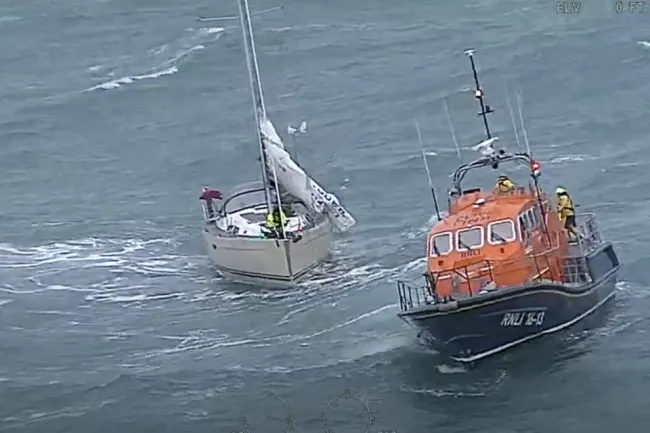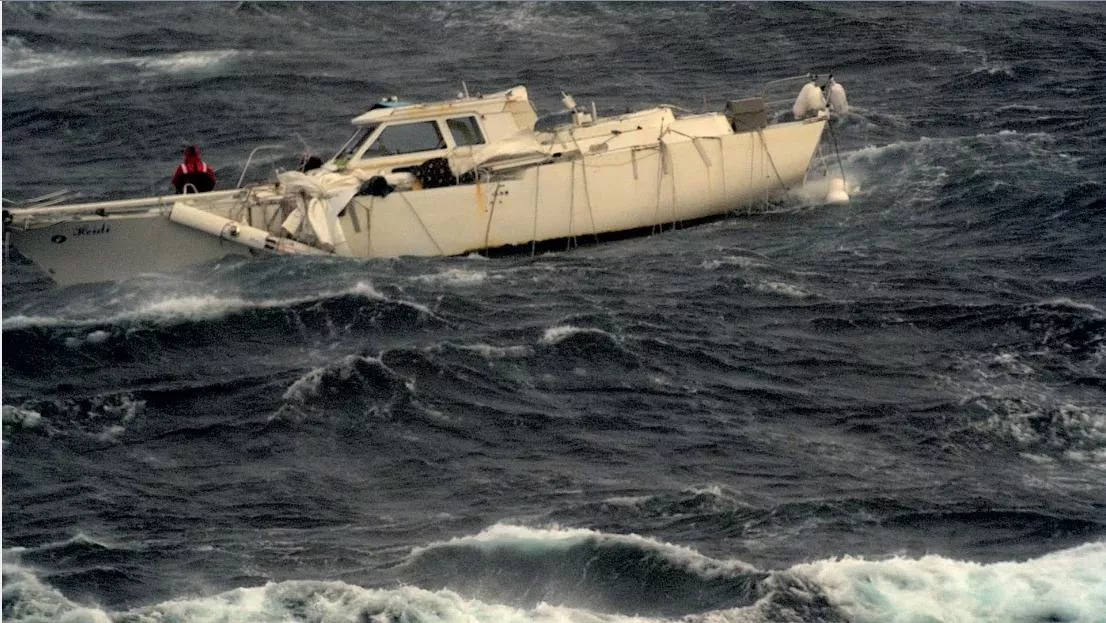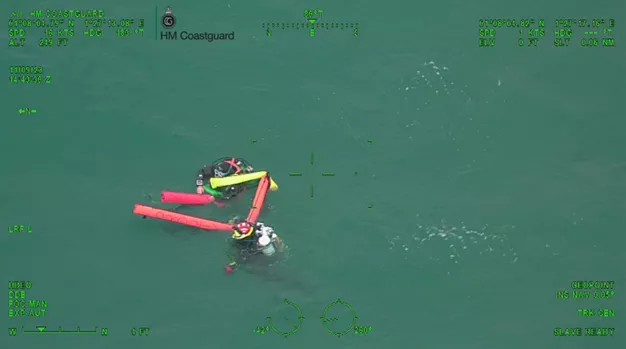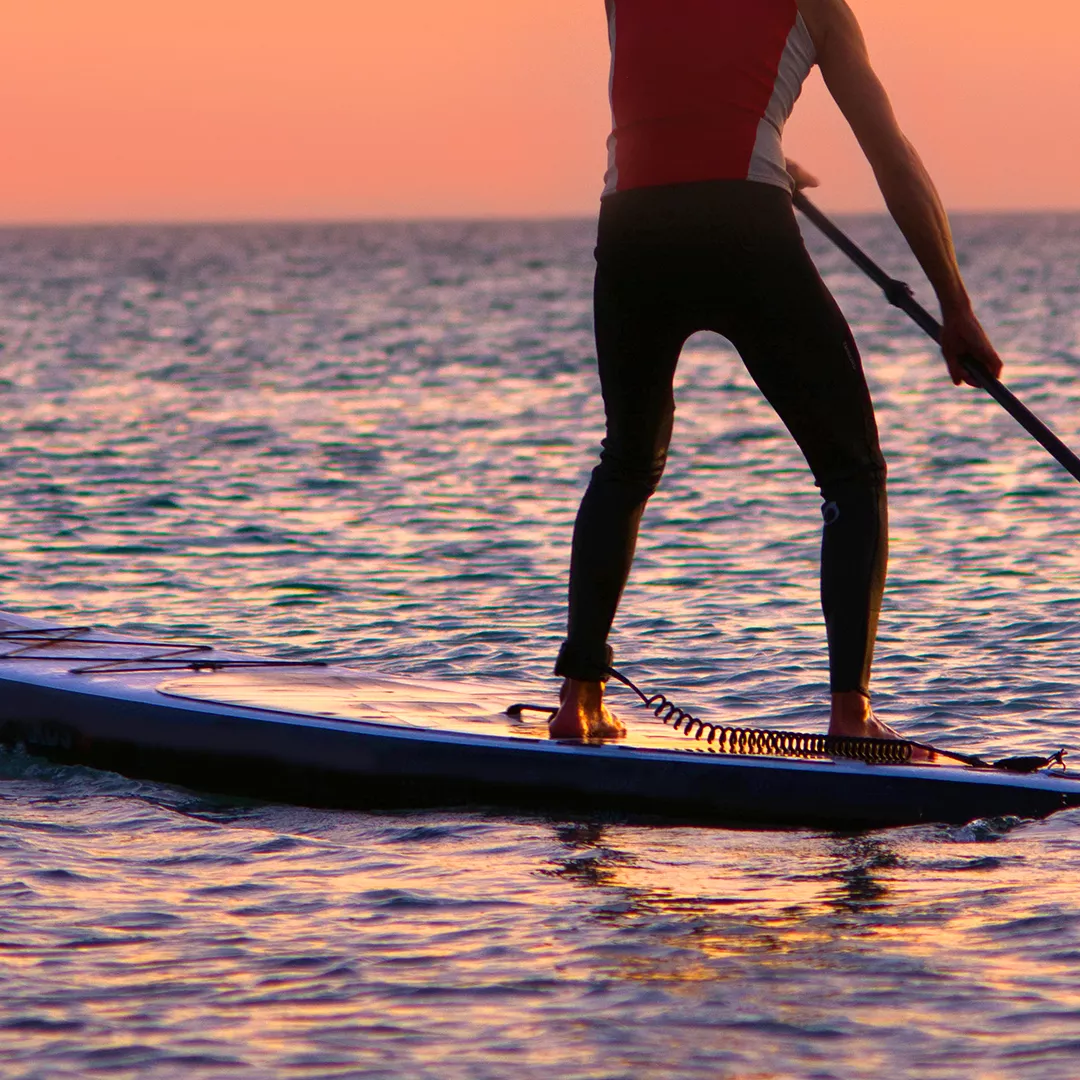The sailor on the 12-metre yacht issued an urgency call after getting into trouble in the severe weather last Friday (31 March), approximately 14 miles north-west of Hartland on the north Devon coast.
The rescue highlights the lifesaving potential of a radio onboard in emergency situations, as the sailor raised the alarm with a Pan Pan call.
Two RNLI volunteer crews from Appledore and Clovelly and the Coastguard helicopter from Newquay were needed to complete the rescue. Appledore’s all-weather lifeboat crew launched at 4.40am into darkness and Gale Force 9 conditions – including 6-metre-high waves. Volunteers onboard Clovelly’s inshore lifeboat later transferred the sailor from the boat to safety.
The exact position of the yacht was initially unclear, with 999 maritime call operators hearing the call but not the location. So the helicopter crew was dispatched to search, while shore-based coastguard teams on the Island of Lundy kept a lookout and spotted a light. The helicopter soon located the floundering vessel and the lifeboat crew.
The yacht’s sails were completely torn but, despite the terrible conditions, Appledore’s crew managed to attach a tow rope to the yacht with the aim of reaching the shelter of Bideford Bay.
The strain of the rough conditions parted the tow rope twice before they reached calmer water off the coast of Clovelly.
After the tow broke for the second time, Clovelly inshore lifeboat crew launched as the safest option was to anchor the yacht and take the sailor off.
Although in calmer water, the strong winds continued to make the sea conditions challenging for Clovelly’s volunteers as they came alongside the yacht to rescue the casualty.
Martin Cox, Appledore RNLI Coxswain said: ‘The weather was quite extreme, with wind speeds of 50 miles per hour the size of the waves were reaching around 6 metres high – at times we couldn’t see the top of the mast on the yacht.
‘Establishing a tow in those conditions was really difficult, and with the tow line breaking more than once, it took a lot of skill from the crew to manage the situation.
‘It was great to be able to work with our neighbouring station at Clovelly to ultimately get the yachtsman ashore in the most challenging condition.’
Kieran Nolan-Jones, Senior Coastal Operations Officer for north Devon, said: ‘It is an important reminder of needing a method to call for help in an emergency situation, the seas can be very unforgiving of those that do not prepare.
‘The yacht had lost all power as well as its sails, and the sailor did the right thing in issuing the Pan Pan alert – but the radio frequency was quite weak. Our helicopter was sent to find the vessel before our lifeboat colleagues did a brilliant job in then safely towing the vessel to harbour. The Lundy Coastguard Rescue Team were really important as well, as they helped to relay the radio messages from a clifftop.
‘It was a tough rescue in tough conditions for everyone involved, the helicopter crew who oversaw it all said the wind was a real challenge.’
When to make a distress or urgency call
Channel 16 is the universal emergency channel, constantly monitored by Coastguards and other nearby vessels. Transmissions on Channel 16 should only be used when absolutely necessary.
There are two types of distress call: Mayday and Pan Pan, to be issued on Ch.16
- MAYDAY, MAYDAY, MAYDAY (pronounced "MAY-DAY" and always spoken three times). This is the international 'distress' signal that is only used to indicate that the vessel is threatened by grave and imminent life-threatening distress and that immediate assistance is required.
- PAN-PAN, PAN-PAN, PAN-PAN (pronounced "PAHN-PAHN" and always spoken three times): This is the 'urgency' signal and is used when the safety of the vessel or a person is at risk, but for the time being at least, does not pose an immediate danger to anyone's life or to the vessel itself. It says ‘a serious situation is developing, we need help but there isn’t a grave and imminent danger to the boat or anyone on board.’
Bottom line
If you feel your life is in jeopardy, call Mayday. If you need immediate assistance to deal with a serious situation that is not life-threatening, call Pan-Pan. A call of ‘Pan-Pan’ can be subsequently upgraded to a 'Mayday' call if the situation worsens and lives becomes endangered.
Method
If you have a DSC radio (digital radio with a distress button), the first action is to activate the red button. This sends a signal to the Coastguard that you are in distress, and newer models will also send your position.
The next step is to make the verbal distress or urgency call. If you hear a distress call, cease all transmission. Unless you are involved in the rescue or providing assistance, no one else is allowed to transmit on the frequency. You should, however, listen and follow the situation until it is evident that assistance is being provided.



